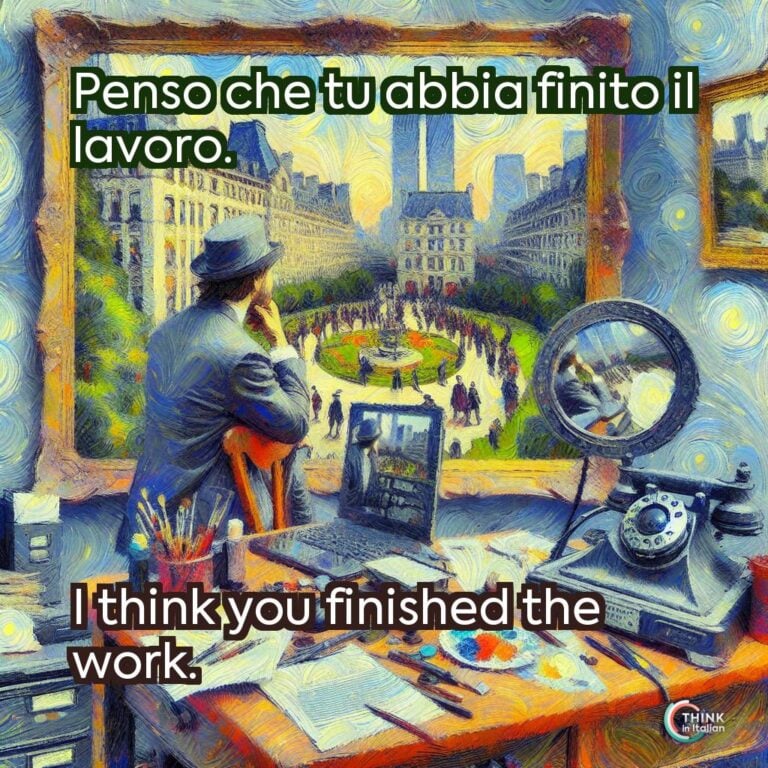The Subjunctive Mood in Italian
The subjunctive mood in Italian, known as congiuntivo, is commonly used in dependent clauses that are introduced by certain conjunctions and expressions, specifically to express:
- a doubt
- a desire
- a necessity
- a possibility
It has four tenses: present, past, imperfect, and past perfect. Here, I will focus on the past perfect subjunctive only.
There are articles dedicated to the present subjunctive, imperfect subjunctive, and past perfect subjunctive too, so go check them out!
Past Subjunctive in Italian
Conjugation
The Italian congiuntivo passato (past subjunctive) is a compound verb. This means that it is composed of the auxiliary verb, either essere or avere and the past participle of the main verb.
As in all compound verbs, the auxiliary verb goes in the corresponding simple tense of that mood. This means that in order for you to conjugate the past perfect subjunctive in Italian, you must know the conjugation of essere and avere in the present subjunctive.
Let me remind you these conjugations:
Avere
| io | abbia |
| tu | abbia |
| lui / lei | abbia |
| noi | abbia |
| voi | abbia |
| loro | abbia |
Essere
| io | sia |
| tu | sia |
| lui / lei | sia |
| noi | sia |
| voi | sia |
| loro | sia |
Penso che loro siano partite poco fa.
I think they left a little while ago.
Credo che Marta abbia finito di lavorare.
I think Marta finished working.
Non sappiamo cosa sia successo.
We do not know what happened.
Remember that avere and essere respectively go with transitive and intransitive verbs and that past participles with the auxiliary essere change according to gender and number of the subject
Also remember that reflexive verbs always select the auxiliary essere!
The past participle of regular verbs, as usual, is formed as follows:
- Past participles of -are🔊 verbs end in –ato
- Past participles of -ere🔊 verbs end in -uto
- Past participles of -ire🔊 verbs end in -ito
Let me show you some examples of the three conjugations:
- Verbs ending in -are
- Ballare (to dance): ballato
- Lavorare (to work): lavorato
- Verbs ending in -ere
- Credere (to believe): creduto
- Sapere (to know): saputo
- Verbs ending in -ire
- Capire (to understand): capito
- Dormire (to sleep): dormito
The past participle of some irregular ones, instead, is as follows:
- aprire(to open) – aperto
- bere(to drink) – bevuto
- chiedere(to ask) – chiesto
- dire (to say) – detto
- fare (to do) – fatto
- leggere (to read) – letto
- perdere (to lose/to miss) –perso
- rompere(to break) – rotto
- scrivere (to write) – scritto
- stare (to stay) – stato
- venire (to come) – venuto
- vedere (to see) – visto
Ho paura che Lucia abia perso l’aereo.
I am afraid Lucia missed her flight.
Non va bene come regalo. Pensiamo che Marco abbia già comprato delle nuove cuffie.
Not a good gift. We think Marco has already bought new headphones.
When to use Congiuntivo Passato
As you might know already, unlike other verb tenses, the Italian congiuntivo is always found in dependent clauses, which means it can never stand alone and always depends on the main clause it depends on.
This is the reason why it’s usually preceded by the conjunction che or se.
In Italian, we use the congiuntivo passato in the following cases:
- To express doubt, uncertainty, or possibility:
Credo che l’Italia abbia vinto il mondiale nel 2006, non 2007.
I think Italy won the World Cup in 2006, not 2007.
Cerco qualcuno che abbia già lavorato in questo settore.
I am looking for someone who already worked in this sector.
- To express desire or hope:
Spero che mio padre abbia cucinato pesce.
I hope my father cooked fish.
Introductory Phrases
Each tense of the congiuntivo mood is introduced by specific introductory verbs or phrases in a specific verb tense.
In the case of congiuntivo passato, these verbs are conjugated in the presente indicativo. This is because we use this verb tense when we are speaking in the present about past actions.
Here are some of the possible introductory verbs you can find and use. Of course, there are many more, as long as they vehiculate doubts, uncertainty, etc…
- Pensare (to think)
- Credere (to believe)
- Sperare (to hope)
- Essere possibile che (to be possible that)
- Sembrare che (to seems that/like)
- A meno che non (unless)
- Affinché (so that)
- Prima che (before)
- Purché (provided that)
Let me give you some more examples:
Non ti sembra che loro siano partiti troppo presto?
Don’t you think they left too early?
Non è possibile che sia già arrivata, è appena partita!
It can’t be that she already arrived, she has just left!
Non compro pesce a meno che non sia stato abbattuto.
I don’t buy fish unless it’s been slaughtered.




